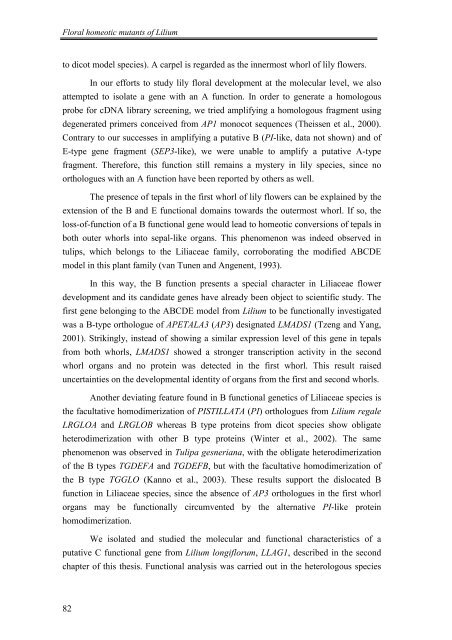Flower development of Lilium longiflorum - The Lilium information ...
Flower development of Lilium longiflorum - The Lilium information ...
Flower development of Lilium longiflorum - The Lilium information ...
Create successful ePaper yourself
Turn your PDF publications into a flip-book with our unique Google optimized e-Paper software.
Floral homeotic mutants <strong>of</strong> <strong>Lilium</strong><br />
to dicot model species). A carpel is regarded as the innermost whorl <strong>of</strong> lily flowers.<br />
In our efforts to study lily floral <strong>development</strong> at the molecular level, we also<br />
attempted to isolate a gene with an A function. In order to generate a homologous<br />
probe for cDNA library screening, we tried amplifying a homologous fragment using<br />
degenerated primers conceived from AP1 monocot sequences (<strong>The</strong>issen et al., 2000).<br />
Contrary to our successes in amplifying a putative B (PI-like, data not shown) and <strong>of</strong><br />
E-type gene fragment (SEP3-like), we were unable to amplify a putative A-type<br />
fragment. <strong>The</strong>refore, this function still remains a mystery in lily species, since no<br />
orthologues with an A function have been reported by others as well.<br />
<strong>The</strong> presence <strong>of</strong> tepals in the first whorl <strong>of</strong> lily flowers can be explained by the<br />
extension <strong>of</strong> the B and E functional domains towards the outermost whorl. If so, the<br />
loss-<strong>of</strong>-function <strong>of</strong> a B functional gene would lead to homeotic conversions <strong>of</strong> tepals in<br />
both outer whorls into sepal-like organs. This phenomenon was indeed observed in<br />
tulips, which belongs to the Liliaceae family, corroborating the modified ABCDE<br />
model in this plant family (van Tunen and Angenent, 1993).<br />
In this way, the B function presents a special character in Liliaceae flower<br />
<strong>development</strong> and its candidate genes have already been object to scientific study. <strong>The</strong><br />
first gene belonging to the ABCDE model from <strong>Lilium</strong> to be functionally investigated<br />
was a B-type orthologue <strong>of</strong> APETALA3 (AP3) designated LMADS1 (Tzeng and Yang,<br />
2001). Strikingly, instead <strong>of</strong> showing a similar expression level <strong>of</strong> this gene in tepals<br />
from both whorls, LMADS1 showed a stronger transcription activity in the second<br />
whorl organs and no protein was detected in the first whorl. This result raised<br />
uncertainties on the <strong>development</strong>al identity <strong>of</strong> organs from the first and second whorls.<br />
Another deviating feature found in B functional genetics <strong>of</strong> Liliaceae species is<br />
the facultative homodimerization <strong>of</strong> PISTILLATA (PI) orthologues from <strong>Lilium</strong> regale<br />
LRGLOA and LRGLOB whereas B type proteins from dicot species show obligate<br />
heterodimerization with other B type proteins (Winter et al., 2002). <strong>The</strong> same<br />
phenomenon was observed in Tulipa gesneriana, with the obligate heterodimerization<br />
<strong>of</strong> the B types TGDEFA and TGDEFB, but with the facultative homodimerization <strong>of</strong><br />
the B type TGGLO (Kanno et al., 2003). <strong>The</strong>se results support the dislocated B<br />
function in Liliaceae species, since the absence <strong>of</strong> AP3 orthologues in the first whorl<br />
organs may be functionally circumvented by the alternative PI-like protein<br />
homodimerization.<br />
We isolated and studied the molecular and functional characteristics <strong>of</strong> a<br />
putative C functional gene from <strong>Lilium</strong> <strong>longiflorum</strong>, LLAG1, described in the second<br />
chapter <strong>of</strong> this thesis. Functional analysis was carried out in the heterologous species<br />
82














